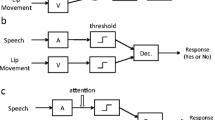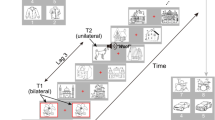Abstract
Intermodal attention (IA) is assumed to allocate limited neural processing resources to input from one specific sensory modality. We investigated effects of sustained IA on the amplitude of a 40-Hz auditory (ASSR) and a 4.3-Hz visual steady-state response (VSSR). To this end, we concurrently presented amplitude-modulated multi-speech babble and a stream of nonsense letter sets to elicit the respective brain responses. Subjects were cued trialwise to selectively attend to one of the streams for several seconds where they had to perform a lexical decision task on occasionally occurring words and pseudowords. Attention to the auditory stream led to greater ASSR amplitudes than attention to the visual stream. Vice versa, the VSSR amplitude was greater when the visual stream was attended. We demonstrate that IA research by means of frequency tagging can be extended to complex stimuli as used in the current study. Furthermore, we show not only that IA selectively modulates processing of concurrent multisensory input but that this modulation occurs during trial-by-trial cueing of IA. The use of frequency tagging may be suitable to study the role of IA in more naturalistic setups that comprise a larger number of multisensory signals.


Similar content being viewed by others
References
Alho K, Woods DL, Algazi A, Naatanen R (1992) Intermodal selective attention. II. Effects of attentional load on processing of auditory and visual stimuli in central space. Electroencephalogr Clin Neurophysiol 82:356–368
Alho K, Woods DL, Algazi A (1994) Processing of auditory stimuli during auditory and visual attention as revealed by event-related potentials. Psychophysiology 31:469–479
Alsius A, Navarra J, Campbell R, Soto-Faraco S (2005) Audiovisual integration of speech falters under high attention demands. Curr Biol 15:839–843
Alsius A, Navarra J, Soto-Faraco S (2007) Attention to touch weakens audiovisual speech integration. Exp Brain Res 183:399–404
Andersen SK, Fuchs S, Müller MM (2011) Effects of feature-selective and spatial attention at different stages of visual processing. J Cogn Neurosci 23:238–246
Berman RA, Colby CL (2002) Auditory and visual attention modulate motion processing in area MT+. Brain Res Cogn Brain Res 14:64–74
Bidet-Caulet A, Fischer C, Besle J, Aguera PE, Giard MH, Bertrand O (2007) Effects of selective attention on the electrophysiological representation of concurrent sounds in the human auditory cortex. J Neurosci 27:9252–9261
Calvert GA, Thesen T (2004) Multisensory integration: methodological approaches and emerging principles in the human brain. J Physiol Paris 98:191–205
de Jong R, Toffanin P, Harbers M (2010) Dynamic crossmodal links revealed by steady-state responses in auditory-visual divided attention. Int J Psychophysiol 75:3–15
de Ruiter MB, Kok A, van der Schoot M (1998) Effects of inter- and intramodal selective attention to non-spatial visual stimuli: an event-related potential analysis. Biol Psychol 49:269–294
Delorme A, Makeig S (2004) EEGLAB: an open source toolbox for analysis of single-trial EEG dynamics including independent component analysis. J Neurosci Methods 134:9–21
Eimer M, Schröger E (1998) ERP effects of intermodal attention and cross-modal links in spatial attention. Psychophysiology 35:313–327
Gander PE, Bosnyak DJ, Roberts LE (2010) Evidence for modality-specific but not frequency-specific modulation of human primary auditory cortex by attention. Hear Res 268:213–226
Ghatan PH, Hsieh JC, Petersson KM, Stone-Elander S, Ingvar M (1998) Coexistence of attention-based facilitation and inhibition in the human cortex. Neuroimage 7:23–29
Grady CL, Van Meter JW, Maisog JM, Pietrini P, Krasuski J, Rauschecker JP (1997) Attention-related modulation of activity in primary and secondary auditory cortex. Neuroreport 8:2511–2516
Griskova I, Morup M, Parnas J, Ruksenas O, Arnfred SM (2007) The amplitude and phase precision of 40 Hz auditory steady-state response depend on the level of arousal. Exp Brain Res 183:133–138
Gutschalk A, Mase R, Roth R, Ille N, Rupp A, Hahnel S, Picton TW, Scherg M (1999) Deconvolution of 40 Hz steady-state fields reveals two overlapping source activities of the human auditory cortex. Clin Neurophysiol 110:856–868
Johnson JA, Zatorre RJ (2005) Attention to simultaneous unrelated auditory and visual events: behavioral and neural correlates. Cereb Cortex 15:1609–1620
Junghöfer M, Elbert T, Tucker DM, Rockstroh B (2000) Statistical control of artifacts in dense array EEG/MEG studies. Psychophysiology 37:523–532
Koelewijn T, Bronkhorst A, Theeuwes J (2010) Attention and the multiple stages of multisensory integration: a review of audiovisual studies. Acta Psychol 134:372–384
Lakatos P, O’Connell MN, Barczak A, Mills A, Javitt DC, Schroeder CE (2009) The leading sense: supramodal control of neurophysiological context by attention. Neuron 64:419–430
Linden RD, Picton TW, Hamel G, Campbell KB (1987) Human auditory steady-state evoked potentials during selective attention. Electroencephalogr Clin Neurophysiol 66:145–159
Macmillan NA, Creelman DC (2005) Detection theory: a user’s guide. Lawrence Erlbaum Associates, Mahwah, New Jersey
Morgan ST, Hansen JC, Hillyard SA (1996) Selective attention to stimulus location modulates the steady-state visual evoked potential. Proc Natl Acad Sci USA 93:4770–4774
Müller MM, Teder-Salejarvi W, Hillyard SA (1998) The time course of cortical facilitation during cued shifts of spatial attention. Nat Neurosci 1:631–634
Müller N, Schlee W, Hartmann T, Lorenz I, Weisz N (2009) Top-down modulation of the auditory steady-state response in a task-switch paradigm. Front Hum Neurosci 3:1
Muller-Gass A, Roye A, Kirmse U, Saupe K, Jacobsen T, Schroger E (2007) Automatic detection of lexical change: an auditory event-related potential study. Neuroreport 18:1747–1751
Näätänen R, Alho K, Schröger E (2002) Electrophysiology of attention. In: Pashler H, Wixted J (eds) Steven’s handbook of experimental psychology: methodology in experimental psychology, vol 4. Wiley, New York, pp 601–653
Oostenveld R, Praamstra P (2001) The five percent electrode system for high-resolution EEG and ERP measurements. Clin Neurophysiol 112:713–719
Quigley C, Andersen SK, Schulze L, Grunwald M, Müller MM (2010) Feature-selective attention: evidence for a decline in old age. Neurosci Lett 474:5–8
Regan D (1989) Human brain electrophysiology: evoked potentials and evoked magnetic fields in science and medicine. Elsevier, New York
Rohrbaugh JW, Varner JL, Paige SR, Eckardt MJ, Ellingson RJ (1990) Auditory and visual event-related perturbations in the 40 Hz auditory steady-state response. Electroencephalogr Clin Neurophysiol 76:148–164
Ross B, Picton TW, Herdman AT, Pantev C (2004) The effect of attention on the auditory steady-state response. Neurol Clin Neurophysiol 2004:22
Saupe K, Widmann A, Bendixen A, Müller MM, Schröger E (2009a) Effects of intermodal attention on the auditory steady-state response and the event-related potential. Psychophysiology 46:321–327
Saupe K, Schröger E, Andersen SK, Müller MM (2009b) Neural mechanisms of intermodal sustained selective attention with concurrently presented auditory and visual stimuli. Front Hum Neurosci 3:58
Senkowski D, Saint-Amour D, Gruber T, Foxe JJ (2008) Look who’s talking: the deployment of visuo-spatial attention during multisensory speech processing under noisy environmental conditions. Neuroimage 43:379–387
Shomstein S, Yantis S (2004) Control of attention shifts between vision and audition in human cortex. J Neurosci 24:10702–10706
Skosnik PD, Krishnan GP, O’Donnell BF (2007) The effect of selective attention on the gamma-band auditory steady-state response. Neurosci Lett 420:223–228
Talsma D, Kok A (2001) Nonspatial intermodal selective attention is mediated by sensory brain areas: evidence from event-related potentials. Psychophysiology 38:736–751
Talsma D, Kok A (2002) Intermodal spatial attention differs between vision and audition: an event-related potential analysis. Psychophysiology 39:689–706
Talsma D, Doty TJ, Strowd R, Woldorff MG (2006) Attentional capacity for processing concurrent stimuli is larger across sensory modalities than within a modality. Psychophysiology 43:541–549
Talsma D, Senkowski D, Soto-Faraco S, Woldorff MG (2010) The multifaceted interplay between attention and multisensory integration. Trends Cogn Sci 14:400–410
Toffanin P, de Jong R, Johnson A, Martens S (2009) Using frequency tagging to quantify attentional deployment in a visual divided attention task. Int J Psychophysiol 72:289–298
Töllner T, Gramann K, Müller HJ, Kiss M, Eimer M (2008) Electrophysiological markers of visual dimension changes and response changes. J Exp Psychol Hum Percept Perform 34:531–542
Woods DL, Alho K, Algazi A (1992) Intermodal selective attention. I. Effects on event-related potentials to lateralized auditory and visual stimuli. Electroencephalogr Clin Neurophysiol 82:341–355
Acknowledgments
We thank Renate Zahn for help in data recording. Special thanks to Andreas Widmann for technical support. Further thanks to Anne Melzer, Philipp Ruhnau and two anonymous reviewers for comments on the manuscript. This experiment was realised using Cogent 2000 developed by the Cogent 2000 team at the FIL and the ICN and Cogent Graphics developed by John Romaya at the LON at the Wellcome Department of Imaging Neuroscience. Work was supported by the Deutsche Forschungsgemeinschaft, graduate programme “Function of Attention in Cognition” (GRK 1182).
Conflict of interest
None declared.
Author information
Authors and Affiliations
Corresponding author
Rights and permissions
About this article
Cite this article
Keitel, C., Schröger, E., Saupe, K. et al. Sustained selective intermodal attention modulates processing of language-like stimuli. Exp Brain Res 213, 321–327 (2011). https://doi.org/10.1007/s00221-011-2667-2
Received:
Accepted:
Published:
Issue Date:
DOI: https://doi.org/10.1007/s00221-011-2667-2




